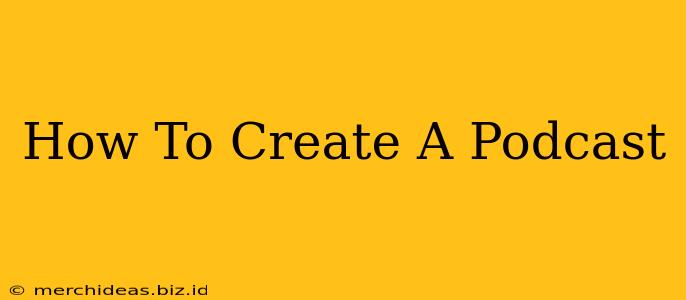Starting a podcast can seem daunting, but with the right approach, it's entirely achievable. This guide breaks down the process into manageable steps, helping you launch your own successful show. Whether you're aiming for a large audience or a niche community, these steps will provide a solid foundation.
1. Planning Your Podcast: Laying the Groundwork
Before you even think about recording, you need a solid plan. This involves several key decisions:
1.1 Defining Your Podcast's Niche and Target Audience:
- What are you passionate about? Your enthusiasm will shine through and keep you motivated.
- What unique perspective can you offer? What makes your podcast different from others?
- Who is your ideal listener? Understanding your audience will shape your content and tone. Are you targeting experts, beginners, or a general audience?
1.2 Choosing a Podcast Name and Branding:
- Keep it concise and memorable. A catchy name is crucial for brand recognition.
- Check for trademark availability. Make sure your chosen name isn't already in use.
- Develop a consistent brand identity. This includes a logo, color scheme, and overall aesthetic.
1.3 Outlining Your Podcast's Format and Content:
- Will it be interview-based, solo commentary, storytelling, or a mix?
- How long will each episode be? Consider your audience's attention span.
- What topics will you cover? Create a content calendar to ensure consistent releases.
2. Essential Equipment for Podcast Creation
You don't need a professional studio to create high-quality audio. However, some essential equipment will significantly improve your sound quality:
2.1 Microphone:
- USB microphones are user-friendly and offer great value.
- XLR microphones provide superior sound quality but require an audio interface.
- Dynamic microphones are robust and handle loud sounds well.
- Condenser microphones are sensitive and capture subtle nuances, ideal for quieter settings.
2.2 Headphones:
- Closed-back headphones prevent sound leakage and allow you to monitor your audio clearly.
2.3 Recording Software:
- Audacity (free): A powerful, free, and open-source option.
- GarageBand (Mac): A user-friendly option pre-installed on Macs.
- Adobe Audition: A professional-grade option with advanced features.
- Reaper: Another powerful option known for its flexibility and features.
2.4 Pop Filter:
A pop filter reduces plosives (hard "p" and "b" sounds) for cleaner audio.
3. Recording and Editing Your Podcast
Once you've got your equipment, it's time to start recording:
3.1 Setting Up Your Recording Space:
- Choose a quiet location with minimal background noise.
- Treat your space acoustically using sound-absorbing materials if necessary.
3.2 Recording Your Podcast:
- Test your equipment before recording.
- Speak clearly and at a consistent pace.
- Maintain good microphone technique.
3.3 Editing Your Podcast:
- Remove any background noise or mistakes.
- Add intro/outro music and sound effects (optional).
- Ensure a consistent audio level.
4. Hosting and Publishing Your Podcast
Getting your podcast out to the world involves hosting and publishing:
4.1 Choosing a Podcast Hosting Provider:
- Libsyn
- Buzzsprout
- Blubrry
- Podbean
These providers offer storage, distribution, and analytics.
4.2 Submitting Your Podcast to Directories:
- Apple Podcasts
- Spotify
- Google Podcasts
- Stitcher
- iHeartRadio
Submitting your podcast to major directories increases its discoverability.
5. Promoting Your Podcast
Creating a great podcast is only half the battle; promoting it is crucial:
5.1 Social Media Marketing:
- Engage with your audience.
- Use relevant hashtags.
- Promote new episodes regularly.
5.2 Guest Appearances:
- Collaborate with other podcasters.
5.3 Website and Email List:
- Create a website to host your show notes and other content.
- Build an email list to keep listeners engaged.
By following these steps, you'll be well on your way to creating and launching your own successful podcast. Remember, consistency and quality are key to building a loyal audience. Good luck!
